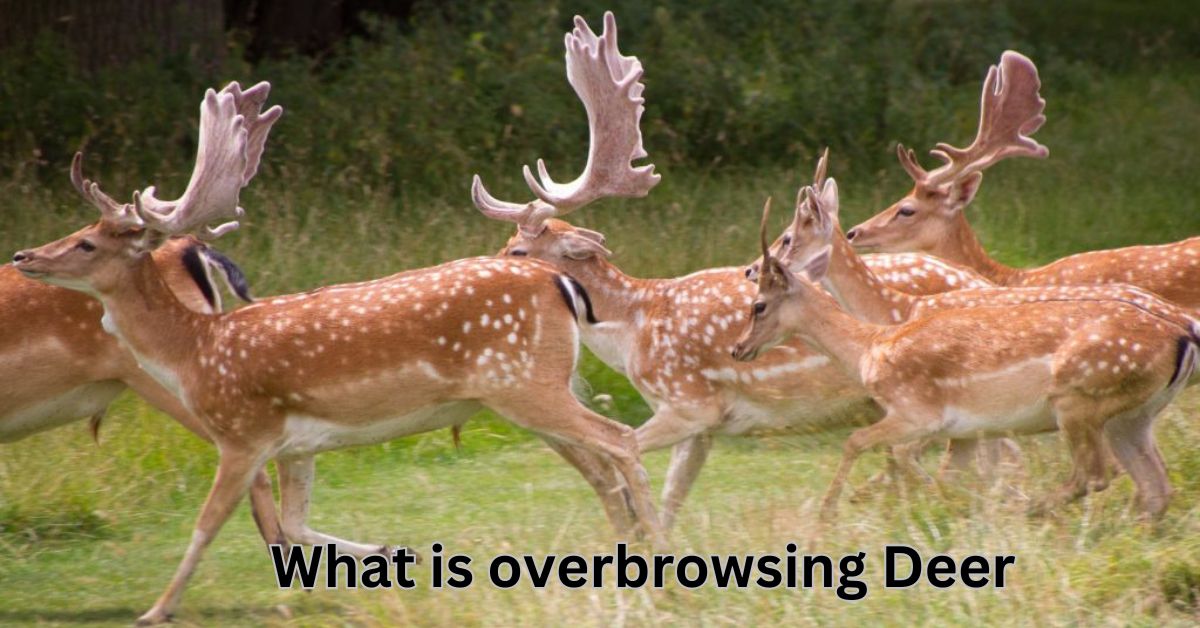GENERAL
What is Overbrowsing in Deer?

What is Overbrowsing in Deer?
Overbrowsing in deer is a term used to describe the detrimental effects caused when deer consume vegetation at unsustainable levels. It is a growing issue in many regions, particularly in areas where deer populations have expanded rapidly due to the lack of natural predators, abundant food resources, and urbanization. This phenomenon has significant ecological, economic, and environmental consequences, impacting plant species, wildlife habitats, and forest regeneration. In this article, we will explore the concept of overbrowsing, how it occurs, its effects on ecosystems, and ways to manage deer populations to reduce overbrowsing.
Understanding Overbrowsing in Deer
Overbrowsing occurs when herbivores, such as deer, consume more vegetation than the environment can regenerate, which leads to a degradation of the ecosystem. Deer, particularly white-tailed deer in North America, are known for their browsing behavior, which involves feeding on a wide variety of plants, including grasses, shrubs, and young trees. While this behavior is natural and essential in controlling plant growth, when deer populations grow too large, they can cause harm to plant life and biodiversity.
In natural ecosystems, herbivores like deer play an important role in maintaining balance. However, when their populations become too dense, they often overconsume vegetation, leading to long-term damage. Overbrowsing can disrupt plant regeneration, create imbalances in plant and animal populations, and alter the structure of forests and other habitats.
Causes of Overbrowsing
Several factors contribute to the occurrence of overbrowsing by deer. These include:
1. Overpopulation of Deer
The most significant driver of overbrowsing is the overpopulation of deer. As deer populations grow, they increase the pressure on available food sources. In some regions, deer populations have expanded dramatically due to the absence of natural predators like wolves and cougars. Additionally, in urban areas, deer often find abundant food sources like ornamental plants, gardens, and farmland. As a result, deer numbers can exceed the ecosystem’s capacity to support them.
2. Lack of Predators
The removal of natural predators has contributed significantly to the growth of deer populations. Predators such as wolves, mountain lions, and coyotes typically help control deer numbers by hunting and reducing their population. However, human activity such as hunting restrictions, habitat destruction, and urbanization has led to a decline in predator numbers, allowing deer populations to thrive uncontrollably.
3. Urbanization and Habitat Fragmentation
As human development encroaches on wildlife habitats, deer populations often migrate into urban and suburban areas where food is readily available. In cities, deer may feed on ornamental plants, shrubs, and trees in yards, parks, and golf courses, exacerbating overbrowsing. Additionally, fragmented habitats make it more difficult for deer to find adequate food sources, prompting them to feed in smaller, more concentrated areas.
4. Mild Winters and Less Predation
In some regions, mild winters lead to fewer harsh environmental conditions, allowing deer to survive with less difficulty. Less severe weather conditions mean that more deer survive the winter, contributing to population growth. Without sufficient natural predators or controlled hunting practices, the population continues to grow, leading to overbrowsing.
Effects of Overbrowsing by Deer
Overbrowsing by deer has a range of negative effects on ecosystems. These effects can have long-term consequences for both plant and animal life. Some of the key impacts include:
1. Loss of Plant Diversity
One of the most immediate consequences of overbrowsing is the loss of plant diversity. Deer preferentially browse on certain species of plants, particularly young saplings, shrubs, and flowers. Over time, this selective feeding can prevent the growth and regeneration of trees and other vegetation. As a result, important plant species may disappear, leading to a less diverse ecosystem. In some cases, entire plant communities may collapse, leading to a decrease in habitat quality for other wildlife species.
2. Forest Regeneration Challenges
Overbrowsing also affects the regeneration of forests. Young trees and seedlings are particularly vulnerable to deer browsing, and as deer consume these plants, they prevent the forest from regenerating naturally. This is particularly problematic in forests that rely on the growth of young saplings to replace older trees. Without new trees to replace mature ones, forests become more vulnerable to disease, pests, and other environmental stresses.
3. Disruption of Wildlife Habitat
Many animal species depend on specific plant species for food and shelter. When deer overbrowse plants, they can indirectly disrupt the habitats of other animals. For example, birds that nest in shrubs and young trees may find their homes destroyed, while small mammals that rely on certain plants for food may be left without resources. Overbrowsing can, therefore, have cascading effects throughout the food chain, affecting entire ecosystems.
4. Increased Soil Erosion
Overbrowsing can also contribute to soil erosion. Many plants play an important role in stabilizing soil, preventing it from being washed away by rainfall. When deer consume too many plants, the lack of vegetation can lead to increased soil erosion. This is particularly problematic in hilly or mountainous areas, where erosion can result in landslides and the loss of fertile soil.
How to Manage Overbrowsing and Deer Populations
Addressing the issue of overbrowsing by deer requires a multi-faceted approach that balances deer population management with ecological restoration. Some of the most common methods for managing overbrowsing include:
1. Controlled Hunting
One of the most effective methods for controlling deer populations and reducing overbrowsing is regulated hunting. Many wildlife management agencies implement hunting seasons and quotas to keep deer populations in check. By carefully controlling the number of deer that are hunted, these agencies can ensure that deer populations remain at sustainable levels.
2. Exclusion Fencing
Exclusion fencing is another technique used to protect vulnerable plants from deer browsing. This involves erecting physical barriers around gardens, farms, or forested areas to keep deer out. While effective, exclusion fencing can be costly and may not be practical for larger areas.
3. Habitat Restoration
Restoring natural habitats and encouraging biodiversity is essential for combating the effects of overbrowsing. This may involve planting a diverse range of native plants that deer are less likely to browse on, as well as providing alternative food sources for wildlife. Habitat restoration can also help to maintain soil stability and encourage the natural regeneration of forests.
4. Public Awareness and Education
Public education and awareness campaigns can help inform people about the importance of controlling deer populations and the ecological impacts of overbrowsing. Encouraging responsible landscaping practices, such as planting deer-resistant plants and reducing food sources in suburban areas, can help prevent deer from migrating into urban spaces where overbrowsing is more likely.
Conclusion
Overbrowsing in deer is a significant ecological issue that has far-reaching effects on plant life, wildlife habitats, and forest regeneration. The causes of overbrowsing are complex, involving factors such as overpopulation, lack of predators, and urbanization. The consequences of overbrowsing are equally severe, leading to the loss of plant diversity, disrupted ecosystems, and increased soil erosion.
To address the issue of overbrowsing, it is essential to implement strategies that manage deer populations and restore natural habitats. Controlled hunting, exclusion fencing, habitat restoration, and public awareness are all crucial components of a comprehensive solution. By taking these steps, we can ensure that deer populations remain in balance with their ecosystems, helping to preserve biodiversity and maintain healthy habitats for future generations.
GENERAL
Unveiling the Woman Behind Andre Hakkak wife
GENERAL
Unpacking R.A.C.E.S: What Does It Really Stand For?
GENERAL
Exploring Canvas Shapes: Unlocking Creative Possibilities

Exploring Canvas Shapes: Unlocking Creative Possibilities
When it comes to creating art, the canvas is often the first thing that artists think about. Traditionally, canvases have been rectangular or square, but today’s artists are embracing a broader variety of canvas shapes that open up new realms of creativity. Exploring canvas shapes can unlock a world of artistic possibilities, allowing artists to break free from convention and experiment with their compositions in unique and exciting ways.
In this article, we will dive into the various canvas shapes available to artists, how to use them to enhance creativity, and how these shapes influence the final artwork. Whether you’re an aspiring artist or an experienced creator, this guide will help you unlock the full potential of your artistic endeavors.
The Traditional Canvas: Rectangular and Square
Before exploring unconventional shapes, it’s important to acknowledge the classic and still widely used rectangular and square canvases. These shapes have been the staple of art for centuries and are associated with some of the most iconic works of art.
1. The Rectangle
The rectangular canvas is the most commonly used shape in traditional art. Whether in landscape or portrait orientation, rectangular canvases provide artists with a balanced area to express their ideas. The long, wide surface is perfect for creating expansive compositions, such as landscapes or cityscapes. Many Renaissance paintings and classical works feature large, rectangular canvases that allowed artists to spread out their scenes and compositions.
-
Landscape Orientation: When using a rectangular canvas in landscape orientation, artists have the freedom to depict expansive vistas, broad landscapes, and horizontal themes. The width of the canvas helps create a sense of space and movement.
-
Portrait Orientation: The portrait orientation is great for portraits, full-body depictions, or vertical compositions that emphasize height or dramatic focus. Portraits of historical figures or spiritual depictions often feature tall, narrow canvases to accentuate their vertical composition.
2. The Square
Square canvases are symmetrical and have an even balance between width and height. While less commonly used than rectangular ones, square canvases are an excellent choice for artists who want to create work that feels equal in all directions. This shape is great for more modern or experimental artwork that doesn’t necessarily rely on the classical concept of space and perspective.
Artists like Piet Mondrian and Andy Warhol utilized square canvases to create their abstract works. The square format allows for a sense of order and harmony in a composition and can often evoke a feeling of stability.
Unlocking Creativity with Non-Traditional Canvas Shapes
While rectangular and square canvases are the most widely used, non-traditional canvas shapes are gaining popularity among artists. These unique canvases encourage experimentation and innovation, pushing artists to think outside the box (literally).
1. Circular Canvases
The circle has been used in art for centuries, representing everything from the cyclical nature of life to the concept of eternity. By using a circular canvas, artists can create a work that focuses on unity and flow. Circular canvases are perfect for creating works that emphasize balance and symmetry.
Circular canvases can be particularly powerful for certain types of artworks, such as mandalas or abstract compositions. The continuous curve of the circle draws the eye inward and encourages the viewer to examine the artwork from all angles. Additionally, circular canvases are excellent for creating paintings that have a spiritual or cosmic feel.
2. Triangular Canvases
For those seeking to explore geometry and abstract concepts, triangular canvases provide a striking option. A triangle naturally suggests stability and balance, but it can also be dynamic and challenging depending on how it is oriented. Artists can play with the angles and lines of a triangular canvas to create visual tension or harmony.
Triangular canvases are often seen in modern and contemporary art, where the artist might use the shape to emphasize angles, edges, and geometric patterns. Triangular canvases can also evoke themes of direction or movement, as the sharp points of the triangle suggest forward momentum.
3. Oval Canvases
An oval canvas is an elegant choice for artists who want to create a unique composition with a sense of movement and flow. The oval shape can create a softer, more organic feel, which is ideal for figurative and nature-inspired work. Oval canvases are often used in portraiture, as the shape complements the human form and adds an element of fluidity to the composition.
Oval canvases are less common than other shapes, making them an excellent choice for artists looking to differentiate their work. They can evoke themes of transformation, natural beauty, and the passage of time, depending on the subject matter.
4. Custom-Shaped Canvases
One of the most exciting aspects of modern art is the freedom to create custom-shaped canvases. Artists can cut their own canvas into any shape they desire, allowing for complete freedom in composition and expression. This approach is commonly used in installation art and sculpture, where the canvas is treated as a three-dimensional object rather than just a flat surface.
Custom-shaped canvases can be anything from organic, flowing curves to angular, jagged edges that interact with the space around them. Artists can experiment with shapes that evoke specific feelings or ideas, and the shape itself can become an integral part of the artwork’s message.
How Canvas Shapes Influence Artistic Expression
The shape of the canvas you choose can significantly affect how you approach your artwork. Here are some ways in which the canvas shape influences creative expression:
1. Composition and Balance
Different canvas shapes require different approaches to composition. For example, a rectangular canvas often prompts an artist to think in terms of depth, space, and perspective, as it encourages horizontal or vertical lines that lead the viewer’s eye across the work. A circle or oval might lead to a more centralized or symmetrical composition, while triangular shapes could inspire an artist to explore lines, angles, and geometric abstraction.
The canvas shape can determine how an artist organizes their elements, such as the placement of focal points and the use of negative space. In many cases, the shape itself can guide the flow of the artwork, leading to a more intentional and cohesive design.
2. Movement and Emotion
The shape of the canvas can also influence the emotional tone of the piece. A square canvas may evoke feelings of stability and order, while a circle may communicate continuity or infinity. A triangle can create a sense of tension or dynamism, while a custom-shaped canvas can evoke a sense of individuality or abstraction.
In essence, the shape of the canvas becomes an active participant in the artwork, contributing to its overall meaning and emotional impact.
3. Creativity and Innovation
Exploring different canvas shapes encourages innovation. Artists who choose non-traditional shapes are forced to think creatively about how to compose and balance their work. Rather than adhering to conventional forms, artists are empowered to break the rules and experiment with the physicality of the canvas itself.
Custom shapes also allow for more interaction with the surrounding space. For example, an irregularly shaped canvas can influence how the viewer perceives the piece in a gallery setting or in the context of an installation.
Choosing the Right Canvas Shape for Your Artwork
While traditional rectangular and square canvases are tried and true, experimenting with unique shapes can bring new life to your artistic practice. Here are some considerations when selecting the best canvas shape for your work:
-
Subject Matter: Consider how the shape of the canvas will interact with your subject matter. For instance, portrait artists may find oval or circular canvases to be a natural fit, while abstract artists may enjoy the freedom of a triangular or custom-shaped canvas.
-
Message and Emotion: Think about the emotional tone you want to convey. Do you want stability, fluidity, tension, or freedom? The shape of the canvas can amplify these feelings.
-
Space: Consider the space where the artwork will be displayed. Some shapes, such as rectangular or square canvases, may be more suited for traditional gallery walls, while custom shapes or installations might interact better with open spaces.
Conclusion
Exploring canvas shapes is a journey that opens up a world of creative possibilities for artists. By breaking free from traditional formats, artists can discover new ways to express themselves, from geometric abstraction to organic, flowing compositions. Whether you choose a classic rectangular canvas or experiment with circular, triangular, or custom shapes, the right canvas can enhance your creative expression and help you achieve your artistic vision. Embrace the possibilities that different canvas shapes provide, and let your creativity guide the way.
-

 TECHNOLOGY3 months ago
TECHNOLOGY3 months agoWhat happened to spank bang
-

 ENTERTAINMENT3 months ago
ENTERTAINMENT3 months agoWhat Is JerkMate? Exploring the Features and Purpose
-

 FASHION3 months ago
FASHION3 months agoUnderstanding the Carmelita Neck: A Unique Fashion Detail
-

 GENERAL3 months ago
GENERAL3 months agoUnveiling the 322 Messianic Prophecies: A Deep Dive
-

 BUSNIESS3 months ago
BUSNIESS3 months agoCrypto FintechZoom: Navigating the Future of Digital Finance
-

 FASHION3 months ago
FASHION3 months agoDebonair blog:The Art of Stylish Living
-

 ENTERTAINMENT3 months ago
ENTERTAINMENT3 months agoDrake Exposed: The Untold Truth Behind the Music and Fame
-

 ENTERTAINMENT3 months ago
ENTERTAINMENT3 months agoWhat Does It Mean to Be a Scratch Golfer?


